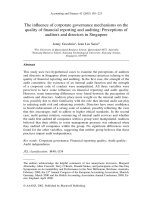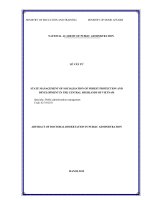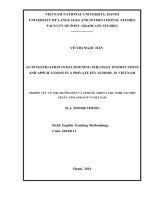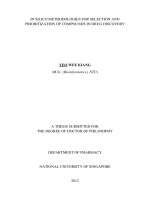Biointormatics of targeted therapeutics and applications in drug discovery
Bạn đang xem bản rút gọn của tài liệu. Xem và tải ngay bản đầy đủ của tài liệu tại đây (5.6 MB, 232 trang )
BIOINFORMATICS OF TARGETED THERAPEUTICS AND
APPLICATIONS IN DRUG DISCOVERY
Qin Chu
(B.Sc. (Hons.), NUS)
A THESIS SUBMITTED
FOR THE DEGREE OF DOCTOR OF PHILSOPHY
NUS GRADUATE SCHOOL FOR INTEGRATIVE
SCIENCES AND ENGINEERING
NATIONAL UNIVERSITY OF SINGAPORE
2014
Bioinformatics of Targeted Therapeutics and Applications in Drug Discovery
Declaration
I hereby declare that the thesis is my original work and it has been written by me in
its entirety. I have duly acknowledged all the sources of information which have
been used in the thesis.
This thesis has also not been submitted for any degree in any university previously.
Qin Chu
18 August 2014
Bioinformatics of Targeted Therapeutics and Applications in Drug Discovery
Bioinformatics of Targeted Therapeutics and Applications in Drug Discovery
i
Acknowledgements
First and foremost, I would like to express my heartfelt appreciation to my
supervisor, Professor Chen Yu Zong, for his invaluable guidance on my research
projects and inspiring encouragement throughout the years.
Many thanks to my thesis advisory committee members A/Prof Chandra Shekhar
Verma and Dr Yap Chun Wei for providing insightful comments on my research and
devoting their time to be my qualification examination examiners.
I wish to thank all the previous and current members of the BIDD group for the
valuable discussions and timely help in the past four years. And my sincere
appreciation goes to my friends for their encouragement and trust all the time.
Lastly but most importantly, my deepest appreciation and love is dedicated to my
family. Your unconditional love is my source of courage and happiness.
Bioinformatics of Targeted Therapeutics and Applications in Drug Discovery
ii
Bioinformatics of Targeted Therapeutics and Applications in Drug Discovery
iii
Table of Contents
Declaration 1
Acknowledgements i
Summary vii
List of Tables xi
List of Figures xiv
List of Abbreviations xvii
List of Publications xix
Chapter 1: Introduction 1
1.1 Overview of targeted therapeutics in modern drug discovery 1
1.2 The importance of multi-target therapeutics 6
1.3 More personalized targeted therapeutics driven by biomarkers 7
1.4 Bioinformatics methods for analysis of targeted therapeutics 10
1.4.1 The update of therapeutic target database to serve as an integrated
information platform of targeted therapeutics 10
1.4.2 Machine learning methods to predict multi-target agents from large
chemical libraries 12
1.4.3 Clustering method to analyse the distribution patterns of targeted
drugs in target-specific chemical space 15
1.4.4 Systematic analysis to study synergistic combinations of natural
Bioinformatics of Targeted Therapeutics and Applications in Drug Discovery
iv
products as potential sources of multi-targeted therapeutics 18
1.4.5 Analysis of biomarker for personalized medicine 20
1.5: Outline of thesis 22
Chapter 2 Update of therapeutic target database as an integrated source of targeted
therapeutics data 25
2.1 Statistics of updated targeted therapeutics in TTD 26
2.2 Materials and methods. 29
2.2.1 Data collection method 29
2.2.2. Data sources 31
2.3. Data in TTD and ways to access them 34
2.3.1 Overall search and download options 34
2.3.2 Targets and drugs 40
2.3.3 Biomarkers 46
2.3.4 Multi-target agents and drug combinations 51
2.3.5 International Classification of Disease 52
2.4 Future work 57
Chapter 3: Methods to learn from known drugs and inhibitors for the design of
multi-target small molecule drugs 59
3.1 Evaluation of Hit and Target Selection Performance of Machine Learning
Multi-Target Virtual Screening Methods 59
3.1.1 Method 60
Bioinformatics of Targeted Therapeutics and Applications in Drug Discovery
v
3.1.2 Results and discussion 71
3.1.3 Future work 81
3.2 Hints of drug prolific regions and properties by clustering drugs in the
target-specific chemical space 83
3.2.1 Data collection and method 84
3.2.2 Preliminary results 87
Chapter 4. Specific multi-target modes identified by analysing synergistic natural
product combination 98
4.1 Method 101
4.2 Results and discussion 103
4.2.1 Comparison of the potencies of natural products and drugs in
cell-based assays 103
4.2.3 Potency enhancing molecular modes of natural product combinations107
4.3 Summary 117
Chapter 5: Personalized targeted theraupeutics driven by biomarkers 120
5.1 More refined classification of patient subpopulations for personalized
targeted therapeutics 121
5.2 Non-invasive biomarker and their applications to healthcare 126
5.2.1 Background 126
5.2.2 Evaluation of new biomarker-detection technologies 130
5.2.3 The relevance and accuracies of the non-invasive molecular
Bioinformatics of Targeted Therapeutics and Applications in Drug Discovery
vi
biomarkers for mhealth applications 131
5.2.4 A digitally-coded biomarker, disease and therapeutic information
processing system 133
5.2.5 Future work 134
Chapter 6: Concluding remarks 154
Bibliography 159
Appendices 171
Bioinformatics of Targeted Therapeutics and Applications in Drug Discovery
vii
Summary
The modern rational drug discovery process starts with the hypothesis that
modulation of certain targets may exert therapeutic value and therapeutics directed
at those targets are then developed to combat diseases. In this big data era, the large
and complex collection of various targeted therapeutics data call for efficient data
management and analysis methods. The development of databases to curate, store,
integrate and retrieve data and methods to analyze and visualize data are of
importance and practical use to increase the success rate of drug discovery.
This work starts with the update of the Therapeutic Target Database (TTD), which
serves as a comprehensive, reliable and integrated information source of
therapeutics data, including drug targets, drug molecules, natural products and
biomarkers. The search tools implemented by the International Classification of
Disease (ICD) codes were added to link and retrieve the target, biomarker and drug
information. Biomarker information was newly added to the TTD and the data
contents were significantly expanded. The updated TTD database enables more
convenient data access and will facilitate the discovery, investigation, application,
monitoring and management of targeted therapeutics.
An important strategy in targeted therapeutics is the use of multi-target therapeutics
such as multi-target drugs and drug combinations, which are more efficacious and
Bioinformatics of Targeted Therapeutics and Applications in Drug Discovery
viii
less prone to resistance than single-target drugs for heterogenetic diseases like
cancer. To facilitate the multi-target drug discovery, bioinformatics methods such as
machine learning methods to predict multi-target inhibitors, clustering method to
look for drug prolific regions and properties and systematic analysis of synergistic
natural product combinations were developed based on the information from TTD.
Three machine learning methods, support vector machine (SVM), K-Nearest
Neighbor( kNN) and probabilistic neural network (PNN) were developed as virtual
screening tools to predict dual-target inhibitors from large chemical libraries.
Models of 29 targets pairs with varying similarity levels between their drug-binding
domains were developed and showed good performance with reasonably high yields
and low false hit rates. But the target selectivity performance of these VS tools needs
improvement. In search of clues to further modify the virtual hits for drug
development, a hierarchical clustering method was proposed to cluster known drugs
in the chemical space. Preliminary investigation seemed to hint some drug prolific
regions and properties.
Moreover, natural product combinations was systematically analyzed to learn novel
multi-target mechanisms. And it was found that most of the evaluated natural
products and combinations are sub-potent to drugs. Sub-potent natural products can
be assembled into combinations of drug level potency, though at relatively low
Bioinformatics of Targeted Therapeutics and Applications in Drug Discovery
ix
probabilities. Distinguished multi-target modes were identified and could shed light
to the design of multi-target therapeutics.
In view of the current shift of drug development focus to more personalized targeted
therapeutics, the collected comprehensive set of biomarkers and the relevant
information were systematically analyzed. The analysis of current biomarkers in
TTD with respect to ICD disease classifications suggested that biomarker (especially
multi-marker), target and drug information may be incorporated into revised ICD
codes for coding disease subclasses and refining patient and drug-response
sub-populations for personalized treatment. In addition, the feasibility of utilizing
non-invasive biomarkers for mobile health applications was discussed.
Bioinformatics of Targeted Therapeutics and Applications in Drug Discovery
x
Bioinformatics of Targeted Therapeutics and Applications in Drug Discovery
xi
List of Tables
Chapter 2
Table 2. 1 Statistics of the drug targets, drugs and their structure and potency data in
2014 version of TTD database. 28
Table 2. 2 List of ICD-9-CM and ICD-10-CM code blocks and the corresponding
classes of diseases and related health problems 54
Chapter 3
Table 3. 1 Datasets of individual-target and multi-target inhibitors of the target-pairs
used for developing and testing machine learning multi-target inhibitor virtual
screening tools. Additional sets of 17 million PubChem compounds and 168,000
MDDR active compounds were also used for the test. 62
Table 3. 2 Virtual screening performance of combinatorial SVMs for identifying
dual-target inhibitors of high similarity target pairs 71
Table 3. 3 Overall statistics of drugs, inhibitors, structurally similar approved drugs
directed to other drugs, similar bioactive Chembl compounds and similar
non-bioactive Pubchem compounds to be clustered. 84
Table 3. 4 Statistics of drugs, inhibitors, structurally similar approved drugs directed
to other drugs, similar bioactive Chembl compounds and similar non-bioactive
Pubchem compounds in each subtree. 89
Bioinformatics of Targeted Therapeutics and Applications in Drug Discovery
xii
Chapter 4
Table 4. 1 The targets and potency-enhancing synergistic molecular modes of the
anticancer combination of Tetraarsenic tetrasulfide, Indirubin, and Tanshinone IIA
(anticancer synergism reported in literature(161))). 109
Table 4. 2 The targets and potency-enhancing synergistic molecular modes of the
anti-rotavirus combination of Theaflavin, Theaflavin-3-monogallate,
Theaflavin-3'-monogallate, and Theaflavin-3,3' digallate (anti-rotavirus synergism
reported in literature (162)). 112
Table 4. 3 Expression profiles of the primary targets and some of the
potency-enhancing secondary targets of the selected natural product combinations in
specific patient groups 118
Chapter 5
Table 5. 1 Approved and clinically tested biomarkers for facilitating the prescription
of a particular drug to specific patient subpopulation 121
Table 5. 2 Examples of diseases and their molecular or cell-based subtypes, ICD
codes (marked as NA if unavailable), and the availability (A) or unavailability (NA)
of the corresponding diagnostic, prognostic and theragnostic biomarkers and if one
or more biomarkers are in clinical use or trial 123
Table 5. 3 New biomarker-detection technologies. 135
Bioinformatics of Targeted Therapeutics and Applications in Drug Discovery
xiii
Table 5. 4 Diseases covered by non-invasive molecular biomarkers 138
Table 5. 5 Conventional test performance 152
Bioinformatics of Targeted Therapeutics and Applications in Drug Discovery
xiv
List of Figures
Chapter 1
Figure 1. 1 Modern drug discovery process 2
Chapter 2
Figure 2. 1 Screenshot of TTD home page. 36
Figure 2. 2 Screenshot of TTD customized search 37
Figure 2. 3 Screenshot of TTD customized search of biomarkers 38
Figure 2. 4 Screenshot of database download page in TTD. 39
Figure 2. 5 Screenshots of detailed information page of ABL1 target. 43
Figure 2. 6 Screenshots of detailed information page of drug Imatinib 46
Figure 2. 7 Screenshot of biomarker detail information of p53. 50
Chapter 3
Figure 3. 1 Dual model performance of three machine learning methods. 75
Figure 3. 2 Selectivity of three methods against individual-target inhibitors 78
Figure 3. 3 The virtual hit rates of three machine learning methods to screen MDDR80
Figure 3. 4 Distribution graph of FLT3 subtree ID 10, labelled according to potency
values. The labels are colored as follows: red for Approved drug, purple for Phase
III drug, pink for Phase II drug, blue for Phase I drug, cyan for other drugs, green for
inhibitors, grey for similar Chembl compounds, pale grey for similar Pubchem
compounds. 94
Bioinformatics of Targeted Therapeutics and Applications in Drug Discovery
xv
Figure 3. 5 Distribution graph of FLT3 subtree ID 10, labelled according to ligand
efficiency values. The labels are colored as follows: red for Approved drug, purple
for Phase III drug, pink for Phase II drug, blue for Phase I drug, cyan for other drugs,
green for inhibitors, grey for similar Chembl compounds, pale grey for similar
Pubchem compounds 95
Figure 3. 6 Distribution graph of FLT3 subtree ID 10, labelled according to the
calculated clogP values. The labels are colored as follows: red for Approved drug,
purple for Phase III drug, pink for Phase II drug, blue for Phase I drug, cyan for
other drugs, green for inhibitors, grey for similar Chembl compounds, pale grey for
similar Pubchem compounds 96
Figure 3. 7 Distribution graph of FLT3 subtree ID 10, labelled according to
molecular weight. The labels are colored as follows: red for Approved drug, purple
for Phase III drug, pink for Phase II drug, blue for Phase I drug, cyan for other drugs,
green for inhibitors, grey for similar Chembl compounds, pale grey for similar
Pubchem compounds 97
Chapter 4
Figure 4. 1 Potency distribution profiles of 88 and 650 anticancer drugs and natural
products. 104
Figure 4. 2 Potency distribution profiles of 102, 609 and 99 antibacterial drugs,
natural products (NPs) and NP extracts. 105
Figure 4. 3 Synergism level of 124 synergistic NP combinations. VSS, SS, S, MS,
Bioinformatics of Targeted Therapeutics and Applications in Drug Discovery
xvi
sS: very strong, strong, normal, moderate, slight synergism, NA: nearly additive, SA,
MA: slight, moderate antagonism. 106
Figure 4. 4 The potency improvement profile of the constituent NPs. 107
Chapter 5
Figure 5. 1 Disease-coverage profiles of the biomarkers. 128
Bioinformatics of Targeted Therapeutics and Applications in Drug Discovery
xvii
List of Abbreviations
ACE
Angiotensin converting enzyme
ATC
Anatomical Therapeutic Chemical
B2AR
Beta-2 adrenoreceptor
CAS
Chemical Abstracts Service
CDK
Cyclin-dependent kinase
CI
Combination index
COX2
Cyclooxygenase-2
CV
Cross validation
DA1R
Dopamine D1 receptor
DRI
Dose reduction index
ELISA
Enzyme-linked immunosorbent assay
FDA
Food and drug administration
FGFR
Fibroblast growth factor receptor
FLT3
Fms-related tyrosine kinase 3
FN
False negatives
FP
False positives
GI
Growth inhibition
HTS
High-throughput screening
IC
Inhibitory concentration
ICD
International Classification of Disease
iTOL
Interactive tree of life
KEGG
Kyoto Encyclopedia of Genes and Genomes
kNN
k-nearest neighbor
LE
Ligand efficiency
MCC
Matthews Correlation Coefficient
MDDR
MDL Drug Data Report
mHealth
Mobile health
MIC
Minimum inhibitory concentration
MIP
Molecular interaction profile
MMP
Matrix metalloproteinase
MS
Mass spectrometry
mTOR
Mammalian target of rapamycin
MW
Molecular weight
NCI
National Cancer Institute
NET
Norepinephrine transporter
NIH
National Institute of Health
NP
Natural products
NSCLC
Non-small cell lung cancer
PCR
Polymerase chain reaction
Bioinformatics of Targeted Therapeutics and Applications in Drug Discovery
xviii
PDB
Protein Data Bake
PDGFR
Platelet-derived growth factor receptor
PNN
Probabilistic neural network
QSAR
Quantitative structure–activity relationship
SE
Sensitivity
SERT
Serotonin transporter
SNOMED
Systematized nomenclature of medicine
SP
Specificity
SRC
Proto-oncogene tyrosine-protein kinase Src
SVM
Support vector machine
TN
True negatives
TP
True positives
TTD
Therapeutic Target Database
UMLS
Unified medical language system
VEGFR
Vascular Endothelial Growth Factor Receptor
VS
Virtual screening
WHO
World Health Organization
Bioinformatics of Targeted Therapeutics and Applications in Drug Discovery
xix
List of Publications
1. Therapeutic Target Database Update 2014: a Resource for Targeted
Therapeutics. C. Qin, C. Zhang, F. Zhu, F. Xu, S.Y. Chen, P. Zhang, Y.H. Li,
S.Y. Yang, Y.Q. Wei, L. Tao and Y.Z. Chen. Nucleic Acids
Res. 42(1):D1118-23 (2014).
2. What does it Take to Synergistically Combine Sub-potent Natural Products
into Drug-level Potent Combinations? C. Qin, K.L. Tan, C.L. Zhang, C.Y.
Tan, Y.Z. Chen and Y.Y. Jiang. PLoS ONE. 7(11):e49969 (2012).
3. Are Molecular Biomarker Based Mobile Health Technologies Ready for
Healthcare Applications? C. Qin, L. Tao, C. Zhang, S. Y. Chen, P. Zhang, S.
Y. Yang, Y. Q. Wei and Y. Z. Chen. Submitted.
4. A Resource for Facilitating the Development of Tools in the Education and
Implementation of Genomics-Informed Personalized Medicine. C. Zhang, C.
Qin, L. Tao, F. Zhu, S.Y. Chen, P. Zhang, S.Y. Yang, Y. Q. Wei, Y.Z.
Chen. Clin Pharmacol Ther. 95(6):590-1. (2014).
5. Clustered Patterns of Species Origins of Nature-derived Drugs and Clues for
Future Bioprospecting. F. Zhu, C. Qin, L. Tao, X. Liu, Z. Shi, X.H. Ma, J. Jia,
Bioinformatics of Targeted Therapeutics and Applications in Drug Discovery
xx
Y. Tan, C. Cui, J.S. Lin, C.Y. Tan, Y.Y. Jiang and Y.Z. Chen. PNAS.
108(31):12943-8 (2011).
6. Nature‟s Contribution to Today‟s Pharmacopeia. L. Tao, F. Zhu, C. Qin,
C.Zhang, F. Xu, C.Y. Tan, Y.Y. Jiang, Y.Z. Chen. Nat Biotechnol. Accepted
(2014)
7. Therapeutic Target Database Update 2012: A Resource for Facilitating
Target-Oriented Drug Discovery. F. Zhu, Z. Shi, C. Qin, L. Tao, X. Liu, F.
Xu, L. Zhang, Y. Song, X.H. Liu, J.X. Zhang, B.C. Han, P. Zhang and Y.Z.
Chen. Nucleic Acids Res. 40(D1):D1128-D1136 (2012).
8. Drug Discovery Prospect from Untapped Species: Indications from Approved
Natural Product Drugs. F. Zhu, X.H. Ma, C. Qin, L. Tao, X. Liu, Z. Shi, C.L.
Zhang, C.Y. Tan, Y.Y. Jiang and Y.Z. Chen. PLoS ONE. 7(7):e39782 (2012).
9. Combinatorial Support Vector Machines Approach for Virtual Screening of
Selective Multi-Target Serotonin Reuptake Inhibitors from Large Compound
Libraries. Z. Shi, X.H. Ma, C. Qin, J. Jia, Y.Y. Jiang, C.Y. Tan, Y.Z. Chen. J
Mol Graph Model. 32:49-66 (2012).
Chapter 1: Introduction
1
Chapter 1: Introduction
1.1 Overview of targeted therapeutics in modern drug
discovery
From ancient mysterious herbs to modern synthetic chemicals, drugs have been an
integral part in people's health and well-being. It is for the benefit of the whole
society to discover new drugs in the hope of defeating diseases and guarding health.
Because of the natural high demand for new drugs, abundant economic opportunities
exist in the field of pharmaceutical industry. Especially in recent years, with the
rapid development of biological technologies and huge advance in combinatorial
chemistry, the drug discovery in pharmaceutical industry has received roaring
attention and showed promising future. A tremendous amount of money, time and
human resources have been injected into drug discovery, in the hope of finding new
drugs. Statistics show that R&D expenditures in pharmaceutical industry has been
growing at an annual growth of 13% since 1970, which leads to a total 50-fold
increase and reaches 13% of the revenues of pharmaceutical companies. (1) And it is
estimated that it would take 12-15 years, one billion US dollars on average in order
to discover a new drug. (2)









